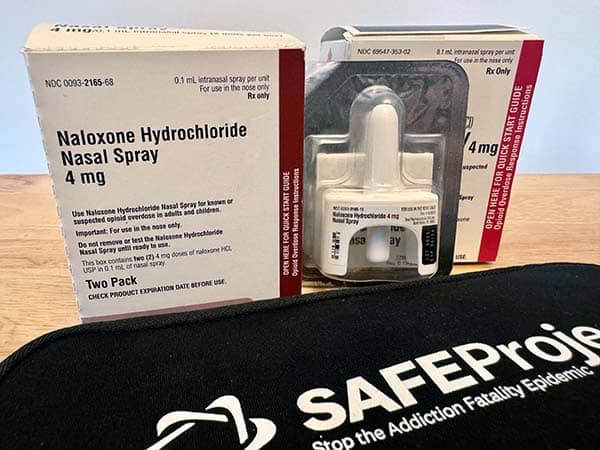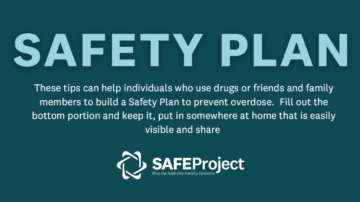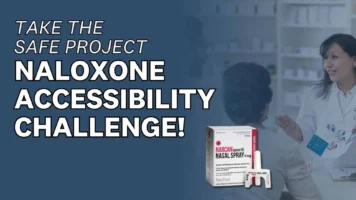What is Naloxone?
Naloxone is a non-scheduled (non-addictive) medication used in opioid overdoses to counteract life-threatening depression of the central nervous system and respiratory system, allowing an individual experiencing an overdose to breathe normally. Naloxone can be administered by non-medical personnel, which makes it ideal for individuals to treat overdose in people who have been prescribed opioid pain medication and in people who use heroin and other opioids. Naloxone only works if a person has opioids in their system and the medication has no effect if opioids are absent (National Harm Reduction Coalition). It may take multiple doses of naloxone to take effect. There is no harm in giving a person who is experiencing an overdose multiple doses of naloxone.
How Can I Get Naloxone?
- Pharmacy: The branded NARCAN® Nasal Spray is now available over-the-counter nationwide. Additionally, individuals can still also purchase naloxone directly from a pharmacist under a statewide standing order, although programming may differ from state to state.
- Insurance: Naloxone is accessible to most insurance holders for a $0 copay. Contact your health insurance provider to find out your coverage and co-pay requirements.
- Naloxone by Mail Through Next Distro: Explore options for finding naloxone in your own community prior to requesting through the mail with NEXT. NEXT is actively working to reserve their resources for those who truly have no other access points available to them.
- Local health departments and community based service providers that serve individuals with substance use disorders may also have naloxone available.
- Local Harm Reduction Agencies are able to offer naloxone and training on how to respond to an opioid overdose, and may have other services that can be helpful for individuals who use drugs and their network. Check for resources in your state via NASEN.

Responding To An Overdose
An overdose happens when a toxic amount of a drug, or combination of drugs overwhelms the body. Opioid overdoses happen when there are so many opioids or a combination of opioids and other drugs in the body that the individual is not responsive to stimulation and/or breathing is inadequate.
Signs of an opioid overdose may include loss of consciousness; unresponsive to outside stimulus; awake but unable to talk; breathing is very slow and shallow, erratic, or has stopped; blue/purple or grayish skin; choking sounds, or a snore-like gurgling noise; vomiting; limp body; a face that is pale or clammy; pulse is slow, erratic, or not there at all. In the event of an overdose, complete the following steps:
STEP 1: Stimulate them awake by yelling their name and administering a hard sternum rub to the chest plate.
STEP 2: If you have naloxone, use it. Administer one dose every two minutes.
- Injectable: Draw up the entire vial and inject it into the thigh muscle.
- Nasal: Stick the device all the way up one nostril and click the plunger, making sure the device is inserted fully (the medication will absorb through the sinuses).
STEP 3: Call 911; explain someone is not responsive and not breathing.
STEP 4: Provide rescue breathing. Get the person on their back, tip their head back to straighten the airway, pinch their nose, put your mouth over theirs and form a seal, one breath every five seconds.
STEP 5: When the person starts to breathe regularly on their own, roll them into a recovery position on their side.
STEP 6: Be gentle with them and yourself afterward!
SAFE Project provides further information on substances and how to respond to an overdoses. For additional questions on opioid overdose reversals, see the National Harm Reduction Coalition’s Overdose FAQs.
A Note About Xylazine
Xylazine is an alpha-2 adrenergic agonist that induces sedation and pain relief in animals such as horses. In the past several years, usage of xylazine by people has increased, contributing to rise of 0.36% of overdose deaths in 2015 to 6.7% in 2020.
When used by people, xylazine can lead to serious health issues, including respiratory depression, cardiovascular disturbances, gastrointestinal problems, and muscle tremors. The drug’s narrow therapeutic window increases the risk of overdose and toxicity, making it potentially life-threatening in excessive amounts. Xylazine can also cause severe skin wounds on the user, leading to additional health complications.
While naloxone can counteract the effects of opioids, it is ineffective against xylazine toxicity, as xylazine acts on different receptors in the central nervous system.
How To Use Fentanyl Test Strips
Fentanyl is a powerful synthetic opioid that is about 50 times stronger than heroin and it can be found in a number of different substances, like heroin, meth, cocaine, and pressed pills. Fentanyl Test Strips can identify the presence of fentanyl in unregulated drugs and can test injectable drugs, powders, and pills. There is not a tool available for finding Fentanyl Test Strips in specific areas but some Harm Reduction Agencies or Health Departments have them available.
What is Harm Reduction?
“Harm reduction is a set of practical strategies and ideas aimed at reducing negative consequences associated with drug use. Harm Reduction is also a movement for social justice built on a belief in, and respect for, the rights of people who use drugs.” (National Harm Reduction Coalition)
“Harm reduction incorporates a spectrum of strategies that includes safer use, managed use, abstinence, meeting people who use drugs ‘where they’re at,’ and addressing conditions of use along with the use itself. Because harm reduction demands that interventions and policies designed to serve people who use drugs reflect specific individual and community needs, there is no universal definition of or formula for implementing harm reduction.” (National Harm Reduction Coalition)
Why Harm Reduction?
Harm Reduction is embedded into SAFE Project’s Core Beliefs and is in line with our efforts to get naloxone into the hands of every individual and into our communities. It is the most effective way to prevent an overdose death. Practicing harm reduction by reversing an overdose can open doors to positive change, non-judgmental care, improved individual and community well-being, and recovery.
LAY. STAY. SPRAY.
Emergent BioSolutions Inc. and SAFE Project have launched a new public education campaign: “Lay, Spray, Stay.” Starring Pro Football legend Emmitt Smith, this campaign aims to prepare people across the country to help save lives with NARCAN® Nasal Spray.

Learn More!
-
 Page
PageHave A Safety Plan
Having a safety plan can help reverse the silence on the addiction epidemic. -



